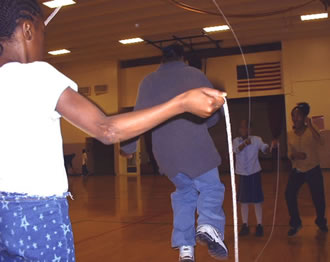 | |
| { I Like Coffee. I Like Tea. I Want You to Jump with Me! } Bill Julin
Joyce Thomas-Washington is a vivacious woman who looks to be in her early thirties but candidly admits being much older. The Community Recreation Director of the North Side's Jefferson Recreation Center is a busy woman—not only is she furthering her education at LaRoche College, but she also runs another center in Fineview. She warmly greets me in the doorway of the Jefferson rec center in a pristine white and red nylon sweat suit with slender framed, slightly hexagonal glasses that match her cream-hazel eyes. She is excited to show me around the newly remodeled building. It's a very homey two-story structure with freshly painted white walls and beautifully treated wood floorboards. I'm a little Dutch girl dressed in blue, here are the things I like to do: Salute the captain, curtsy to the queen, turn my back on a big submarine! As the temperature drops, so does attendance at local playgrounds. Pittsburgh doesn't have a legitimate double Dutch league, so I spent a few afternoons driving around schoolyards looking for jumpers, trying not to look like one of those creepy guys who hangs around the jungle gym and tries to bait kids into his car with Tootsie-Rolls. A list of double Dutch team names that I pulled from the ADDL's Web site became the driving force behind my search: Baby Pepper Steppers, Special King Force, Palpitating Panthers, Tiger Turners, Claim Jumpers, Greenbelt Sity (sic) Stars, Wilson Ropes & Rhythms, Rocky Mountain Ropers, High Desert Revolution, ZZ Skippers, Hot Dog USA, Leaping Leopards, and Ebony Force. There had to be a team with a crazy name to represent Pittsburgh, right? You and him sitting in a tree, K-I-S-S-I-N-G, first comes love, then comes marriage, then comes the baby in a baby carriage! We get out of the car in the and onto the level parking lot blacktop. Joyce and Tara exit the car doors and acknowledge the moonlight. Either the streetlights hadn't been adjusted for daylights savings time, or maybe the lamps had been neglected for a couple of years. We pass the high school football field and walk up the steps to the center. Down by the river, down by the sea, Johnny broke a bottle and blamed it on me. The soft white rope beats a muffled steady rhythm on court. These ropes are three times longer than common jump ropes. Two elementary school-aged girls set the pace; knees bouncing and shoulders swaying, they face each other and carve circles in the air with their arms in perfect synch. Carefully studying the rapid pattern of the two twirling ropes, a third girl gracefully hops inside. She synchronizes her footing to dodge the corded arches as they alternately pass over her head and under her feet. They sing rhymes as they turn the ropes: Cinderella, dressed in yellow, went upstairs to meet her fellow. Tara reminisces of her days in a double Dutch team with Joyce as coach. "I liked jumping and then touching the ground, doing Criss Cross, jumping into the rope then jumping out of the rope, doing the Kid-N-Play. The secret to landing tricks is to just keep one rope out of mind and think of it as regular jump rope. We used to have better ropes than those [points to the ropes that the girls are skipping with]. The plastic ones have the beads on them, and you can hear them better when you're jumping. Some times in the dark, we'd play at night, you can't see the rope but you can hear the rhythm. If the rhythm is messed up then there's no sense in jumping anyway." "Fire, fire, false alarm, Ashante fell into Calvin's arms. Is he gonna be the one? Yes, no, maybe so, yes, no, maybe so." | |
 Call the Army, call the Navy, that girl's gonna have a baby!
Call the Army, call the Navy, that girl's gonna have a baby!